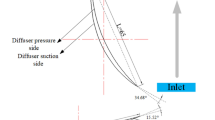Abstract
The helical flow pump (HFP) was invented to be an ideal pump for developing the TAH and the helical flow TAH (HFTAH) using two HFPs has been developed. However, since the HFP is quite a new pump, hydrodynamic characteristics inside the pump are not clarified. To analyze hydrodynamic characteristics of the HFP, flow visualization study using the particle image velocimetry and computational fluid dynamics analysis were performed. The experimental and computational models were developed to simulate the left HFP of the HFTAH and distributions of flow velocity vectors, shear stress and pressure inside the pump were examined. In distribution of flow velocity vectors, the vortexes in the vane were observed, which indicated that the HFP has a novel and quite unique working principle in which centrifugal force rotates the fluid in the helical volutes and the fluid is transferred from the inlet to the outlet helical volutes according to the helical structure. In distribution of shear stress, the highest shear stress that was considered to be occurred by the shunt flow across the impeller was found around the entrance of the inlet helical volute. However, it was not so high to cause hemolysis. This shunt flow is thought to be improved by redesigning the inlet and outlet helical volutes. In distribution of pressure, negative pressure was found near the entrance of the inlet helical volute. However, it was not high. Negative pressure is thought to be reduced with an improvement in the design of the impeller or the vane shape.







Similar content being viewed by others
References
Copeland JG, Smith RG, Arabia FA, Nolan PE, Sethi GK, Tsau PH, McClellan D, Slepian MJ. Cardiac replacement with a total artificial heart as a bridge to transplantation. N Engl J Med. 2004;351:859–67.
Dowling RD, Gray LA, Etoch SW, Laks H, Marelli D, Samuels L, Entwistle J, Couper G, Vlahakes GJ, Frazier OH. Initial experience with the AbioCor implantable replacement heart system. J Thorac Cardiovasc Surg. 2004;127:131–41.
Kormos RL, Borovetz HS, Litwak K, Antaki JF, Poirier VL, Butler KC. HeartMate II left ventricular assist system: from concept to first clinical use. Ann Thorac Surg. 2001;71:S116–20.
Chung MK, Zhang N, Tansley GD, Qian Y. Experimental determination of dynamic characteristics of the VentrAssist implantable rotary blood pump. Artif Organs. 2004;28:1089–94.
Frazier OH, Cohn WE, Tuzun E, Winkler JA, Gregoric ID. Continuous-flow total artificial heart supports long-term survival of a calf. Tex Heart Inst J. 2009;36:568–74.
Fukamachi K, Horvath DJ, Massiello AL, Humoto H, Horai T, Rao S, Golding LAR. An innovative, sensorless, pulsatile, continuous-flow total artificial heart: device design and initial in vitro study. J Heart Lung Transpl. 2010;29:13–20.
Abe Y, Saito I, Isoyama T, Miura H, Shi W, Yamaguchi S, Inoue Y, Nakagawa H, Ono M, Kishi A, Ono T, Kouno A, Chinzei T, Imachi K. A nonpulsatile total artificial heart with 1/R control. J Artif Organs. 2008;11:191–200.
Abe Y, Ishii K, Isoyama T, Saito I, Inoue Y, Ono T, Nakagawa H, Nakano E, Fukazawa K, Ishihara K, Fukunaga K, Ono M, Imachi K. The helical flow pump with a hydrodynamic levitation impeller. J Artif Organs. 2012;15:331–40.
Ishii K, Hosoda K, Isoyama T, Saito I, Ariyoshi K, Inoue Y, Sato M, Hara S, Lee X, Wu S-Y , Ono T, Nakagawa H, Imachi K, Abe Y. Pulsatile driving of the helical flow pump. Conf Proc IEEE Eng Med Biol Soc. 2013:2724–7.
Abe Y, Ishii K, Isoyama T, Saito I, Inoue Y, Sato M, Hara S, Hosoda K, Ariyoshi K, Nakagawa H, Ono T, Fukazawa K, Ishihara K, Imachi K. The helical flow total artificial heart: implantation in goats. Conf Proc IEEE Eng Med Biol Soc. 2013:2720–3.
Hassan YA, Canaan RE. Full-field bubbly flow velocity measurements using a multiframe particle tracking technique. Exp Fluids. 1991;60:49–60.
Arvand A, Hahn N, Hormes M, Akdis M, Martin M, Reul H. Comparison of hydraulic and hemolytic properties of different impeller designs of an implantable rotary blood pump by computational fluid dynamics. Artif Organs. 2004;28:892–8.
Bludszuweit C. Three-dimensional numerical prediction of stress loading of blood particles in a centrifugal pump. Artif Organs. 1995;19:590–6.
Acknowledgments
The study was supported in part by the JSPS KAKENHI (22249053) and (22240054).
Conflict of interest
None to declare.
Author information
Authors and Affiliations
Corresponding authors
Rights and permissions
About this article
Cite this article
Ishii, K., Hosoda, K., Nishida, M. et al. Hydrodynamic characteristics of the helical flow pump. J Artif Organs 18, 206–212 (2015). https://doi.org/10.1007/s10047-015-0828-y
Received:
Accepted:
Published:
Issue Date:
DOI: https://doi.org/10.1007/s10047-015-0828-y



